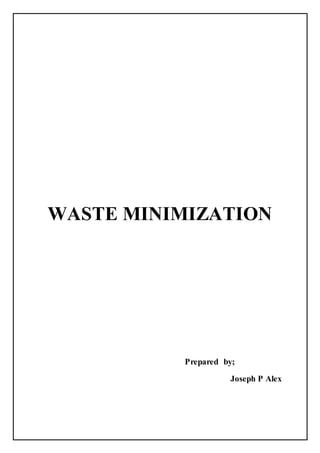
Waste minimization
- 1. WASTE MINIMIZATION Prepared by; Joseph P Alex
- 2. CONTENTS 1. Introduction 2. What is waste? 3. Waste minimisation 4. Waste hierarchy 5. Waste reduction techniques 6. Conclusion 7. Reference
- 3. INTRODUCTION Waste minimization is a process of elimination that involves reducing the amount of waste produced.There are many opportunities for farmers to make financial savings and help the environment through efficient use of resources and improved waste management. Waste minimisation (the reduction of waste at source) should be fundamental to decisions on farm waste management and can reduce the risk of pollution from agricultural activities WHAT IS WASTE? Waste is the unwanted or useless materials generated from activities in a given area.It may be categorized according to its origin (domestic, industrial, commercial, construction or institutional). According to its contents (organic material, glass, metal, plastic paper etc.).According to hazard potential (toxic, non-toxin, flammable, radioactive, infectious etc.). WASTE MINIMISATION Waste minimization can be defined as "systematically reducing waste at source". It means: • Prevention and/or reduction of waste generated • Efficient use of raw materials and packaging • Efficient use of fuel, electricity and water • Improving the quality of waste generated to facilitate recycling and/or reduce hazard • Encouraging re-use, recycling and recovery Benefits of Waste Minimization Minimizing waste will help the business to: Keep waste disposal costs down. Keep raw material costs down. Comply with legislation. Reduce impact on the environment. Perhaps support other businesses – one business’s waste may be another business’s resource.
- 4. WASTE HIERARCHY Waste minimisation can be divided to: Avoid Reduce Reuse Recycle. Energy recovery Disposal 1) Avoid Disposal of an item must be considered before you purchase it.Source Reduction of waste or stopping waste before it starts is a way to enhance environmental cleanliness. Source reduction is also known as waste prevention or pollution prevention, is the elimination of waste before it is created. Source reduction is decreasing the amount of materials or energy used during the manufacturing or distribution of products and packages. Source reduction means stopping waste before it happens. 2) Reduce The easier method of waste management is to reduce creation of waste materials thereby reducing the amount of waste going to landfills. Waste reduction can be done through recycling old materials like jar, bags, repairing broken items instead of buying new one, avoiding use of disposable products like plastic bags, reusing second hand items, and buying items that uses less designing 3) Reuse Using of 2nd hand goods, refillable containers. Repair an item and extend its life. Make an old item into something useful in a new way. 4) Recycle Recycling is the process of converting waste products into new products to prevent energy usage and consumption of fresh raw materials. Recycling is the third component of Reduce, Reuse and Recycle waste hierarchy. The idea behind recycling is to reduce energy usage, reduce volume of landfills, reduce air and water pollution, reduce greenhouse gas emissions and preserve natural resources for future use. 5) Energy recovery Energy or Resource recovery is the process of taking useful discarded items for a specific next use. These discarded items are then processed to extract or recover materials and resources or convert them to energy in the form of useable heat, electricity or fuel.eg: - biogas production
- 5. 6) Disposal Waste must be treated prior to disposal to reduce its hazardous nature. For those things that cannot be reduced, reused or recycled, we ensure that they are disposed of responsibly. WASTE REDUCTION TECHNIQUES There are 4 major waste minimization techniques: 1. Inventory management 2. Production process modification 3. Volume reduction 4. Recovery 1) Inventory management Inventory management is divided into two: • inventory control • materials control a) Inventory Control It involves techniques to reduce inventory size and hazardous chemical use while increasing inventory turnover. Proper inventory control help reduce wastes.Method that can be used are purchasing in small quantities, purchasing in appropriate container sizes and just-in-time purchasing. b) Materials Control Proper control over the storage of raw materials, products and process waste and the transfer of these items within the process and around the facility.Minimize the losses through spills, leaks or contamination. Ensure the material is efficiently handled and used in the production process and does not become waste. 2) Production process modification 3 techniques for production process modification: a) Operation and maintenance procedures b) Material change c) Equipment modifications
- 6. a) operation and maintenance procedures Corrective and preventive maintenance can reduce waste generation caused by equipment failure.This can help spot potential sources of release and correct a problem before any material is lost. b) material change The replacement of materials used in either a product formulation or in a production process, can either result in elimination of a hazardous waste or facilitate recovery of a material. c) equipment modifications Installation of more efficient equipment or modification of equipment can reduce the generation of waste.Installation of completely new equipment may be involved. 3) Volume reduction a) Source segregation b) Concentration a) Source segregation Segregation of wastes allows them to be more readily removed or recovered. b) Concentration Concentrate waste through separation processes such as filtration, centrifugation, membrane separations and evaporations. 4) Recovery a) on-site b) off-site a) On-site Recovery Reduce possible handling losses and allow the management of the waste to remain within the compass of the producer. Recovered material can be reused as raw material. b) Off-site Recovery If on-site recovery is not feasible, for economic or other reasons, off-site recovery should be considered.Waste may be transferred to other company for use as a raw material in the other company’s manufacturing process.
- 7. CONCLUSION There are a number of good reasons for minimizing waste. Source reduction comes at the top of the waste hierarchy. Factors which influence waste minimisation include regulations, technological feasibility, economic viability and management support. There are both incentives and barriers; some opportunities widely applicable - and valuable experience from demonstration REFERENCE https://en.wikipedia.org/wiki/Waste_minimisation http://www.slideshare.net/ymadhusudhanreddy/waste-minimization-14630551 http://www.ehp.qld.gov.au/waste/minimisation/